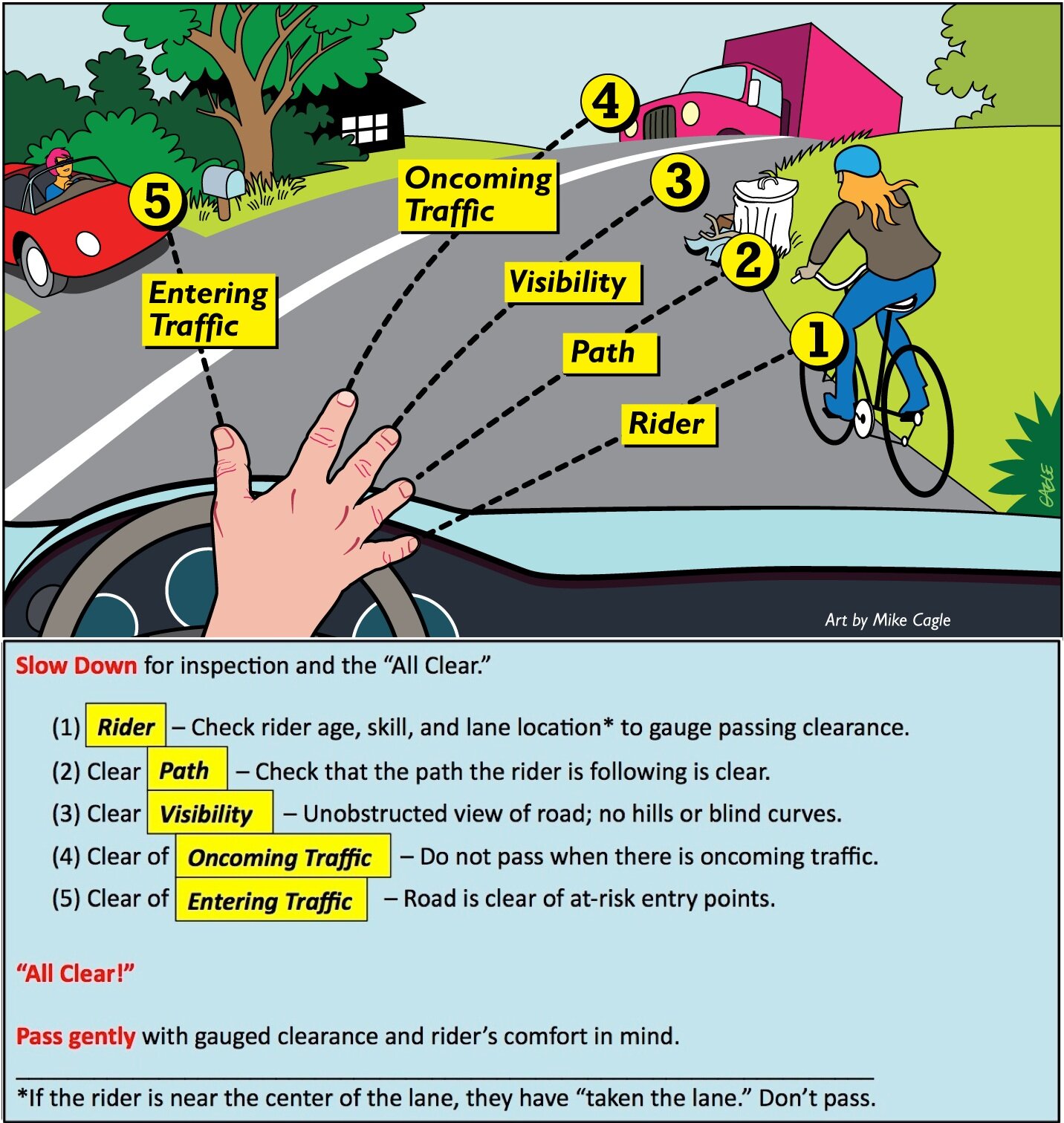The Right-Hand Rule for Passing a Bike
In all my years as a driver, a cyclist, and a transportation planner, I have never seen or heard driving instructions on how to pass a bike. So here are mine. If you think they can be improved, please leave your suggestions in the comments below or email me at transportationjusticeblog@gmail.com. Also, save, share, and distribute the illustration or the illustration with the full description, if you think it’s helpful. I am imagining only good can come from this. — Buff Brown
Since I was a kid, I have had instructions on how to walk across a street firmly jammed into my head. Look both ways. Don’t run. They include a cute little limerick:
Stop, look, and listen,
before you cross the street.
First you use your eyes and ears,
and then you use your feet.
Riding a bicycle is a bit dangerous on its own, even before taking it out in traffic. We have all had bad bike wrecks that did not involve cars; however, most bike deaths involve a motor vehicle. According to the National Center for Health Statistics, 66% of all “preventable” cycling deaths in 2017 involved motor vehicles. One study indicated that in 50% of these car-bike crashes, the fault was attributed to the driver.
As a cyclist, I have been fully indoctrinated in the importance of a helmet, and to ride as far to the right as possible, to ride defensively, assume drivers don’t see me, and watch out for right hooks. I know many people in the bike advocacy world who are certified cycling safety instructors; my local expert on this informs me his curriculum does not include how to pass a cyclist when driving a car. An internet search found some general instructions from bike advocacy groups and bike magazines, but little else. I was happy to find the Oregon Department of Transportation (ODOT) has a flyer, and also has a nice booklet called the Driver’s Guide to Bikes with 18 pages of good advice. ODOT has also partnered with Street Trust and Lane County to create the Oregon Friendly Driver program, but it appears you’ll need to take the class to get the full instructions. I have seen the PowerPoint slides and they are impressive.
According to a July 2018 article from the National Conference of State Legislatures (NCSL), 32 states (and growing) have bike passing-distance laws; the article nicely summarizes each state’s bike-passing laws. I generally hear these described as “3-foot laws”. This is a step in the right direction—it is instructive—but is three feet really a good distance? I’m not sure I have ever passed a cyclist that close. If I did, I’m sorry; I’m sure I scared you. And what about car speed and oncoming traffic? Is passing distance really enough instruction to a driver? Admittedly, some states’ laws do address more than just passing distance, and in some states it is not always three feet. Take a look.
This NCLS article says, “Skeptics doubt such laws can be enforced and whether 3 feet allows sufficient space for bicyclists.” The National Highway Traffic Safety Administration (NHTSA) is “undertaking a research project to determine the effectiveness of safe bicycling laws.” It is to be published in early 2020, so expect more on this later.
My point here is that the instructions I can find tend to instruct the vulnerable victim, not the driver. If drivers were required to learn a set of bike-passing best practices, it could be far more effective in saving lives and improving the comfort of cycling as a mode of transportation. Making these “best practices” the law is even better. Our cultural norm of focusing on the victim’s behavior rather than the offender’s has been applied to people on bikes. Let’s fix that. It appears that people on bikes have also been victim of biased reporting language. Let’s fix that, too.
See this Canadian 3-ft passing enforcement effort complete with a video of the sting operation with 1.8M views and 2.1K comments.
Three weeks ago, my wife and I rode with a group on a country road called Clackamas River Road just outside of Oregon City. In those 16 shoulderless miles of narrow road, there were four different occurrences of truck drivers passing us at full speed with on-coming vehicles in the opposing lane. These four drivers seriously broke the 3-foot rule. These were hostile passes meant to intimidate, and they did so. One included being yelled at by the driver. We won’t be riding that section again. Congratulations, the bullies won. A three-foot law could certainly provide recourse.
In the categories of cyclists, my wife and I fit the “Enthused and Confident” category and will go on to ride again, but those in the “Interested but Concerned” category might have hung up their bikes for good. This driver behavior is not only unsafe, but it is a major reason people don’t bike. This leads to a bike mode share that is tiny, a car mode share that is high, and streets, cities, and a planet that are unhealthy.
Passing these 3-foot laws is a start to instructing drivers on dangerous passing behavior to save lives and affect mode share. But, providing passing instructions to drivers as a matter of course could get us farther; this could be done through public service announcement and health & safety promotion, but preferably in every DMV driving manual and exam. Oregon Senate Bill SB746 attempted to do just that this past session, but it did not get out of committee. Keep trying, Oregon! Please pass on the illustrations, and/or this article. Thank you!
About the Author
Buff Brown has been in transportation planning for 20 years. Originally from Indiana, he worked for the state in transportation air-quality, and as a travel modeler for the Department of Transportation. He now resides in Portland, OR and has worked in transportation for two suburban cities. Buff has engineering, environmental science, and law degrees. His hobbies are cycling, singing, and equity advocacy. He is married with 3 grown daughters. He writes a blog on transportation justice.






An initiative that encourages people to use a bike instead of a car seems like a good thing, but does National Bike to Work Day actually encourage bikeability?